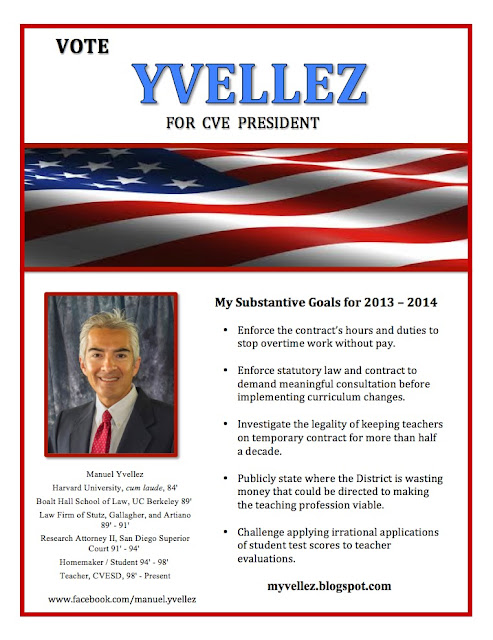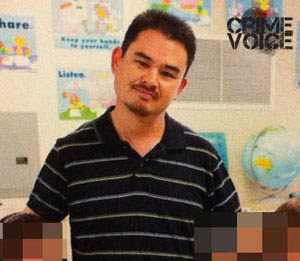![]() Update: Two employees who escaped police chief's bullet are still out on stress leave, but police chief is back on the job
Update: Two employees who escaped police chief's bullet are still out on stress leave, but police chief is back on the job
I was right that the investigation of Liebert, Cassidy, Whitmore would not embarrass the Southwestern College. The law firm, which represents school districts, apparently found absolutely no problem with an upset police chief pulling out his gun and letting a bullet fly in police headquarters at Southwestern College. See updated story at bottom of this post.
"After his reinstatement, Cash dropped in on the office of The Sun and said he would be willing to talk to student journalists about the episode and subsequent events. During a two-and-a-half hour interview Cash again apologized for the gunfire and said the campus community did not need to worry. He refused to say why he was holding his gun that morning, why it was pointed at head level or why he pulled the trigger, citing 'personal confidentiality.'”
"Personal confidentiality"?" I don't think it's a confidential matter when a public employee shoots a gun in his office. The Chula Vista Police Department is failing, in this case, to fulfill its duty to protect the public. It does NOT need a "request" from the college before it investigates.
ORIGINAL POST:
The firm of Liebert, Cassidy, Whitmore represents school districts. I would assume that their investigation will not embarrass Southwestern College.
Police chief on leave following gun fire in HQDavid McViker
The Southwestern College Sun
10/09/2013
Campus Police Chief Michael Cash has been placed on administrative leave pending an investigation of an incident at police headquarters where a gun Cash was holding discharged and a bullet narrowly missed hitting a SWCPD clerk.
College officials have released very little information about the incident, but several sources have informed The Sun that the firing of the police handgun was part of what one described as a “scary and dangerous” situation.
Sources said Cash entered the SWCPD offices and removed his district-issued service weapon from its holster for reasons unknown and the weapon discharged. A single shot penetrated the wall, narrowly missed campus police clerk Grace David and lodged itself into an adjacent wall in the campus police reception area. Sources said it was unclear whether Cash fired the weapon intentionally or whether it was an accidental discharge.
Following the incident, sources said, Cash “had to be talked down” by SWCPD officers. Cash then surrendered the gun and collapsed to the ground, sources said, demonstrating “shock-like symptoms” and was taken away in an ambulance to a nearby hospital for evaluation. He was subsequently released.
David has been placed on medical leave and has not returned to work since the incident. SWCPD Sergeant Robert Sanchez was named acting chief while an investigation is being conducted.
Sources said the college originally planed to ask the Chula Vista Police Department to investigate the discharge, but CVPD spokesperson Captain Gary Wedge said the college has not requested CVPD assistance. Lillian Leopold, SWC Chief Public Infrmation and Government Relations Officer, said
the college has asked the law firm of Liebert, Cassidy, Whitmore to conduct the investigation. Leopold said college officials are not able to discuss the incident while the investigation is pending.
“We want to make sure that there is a thorugh investigation and that both the campus community, and any personnel matter involved with it, are looked at as thoroughly as possible to ensure that there is no attempt to hide any information. Once the investigation is over, it will depend on what we can and cannot release (due to privacy issues.)”
Some college employees, however, expressed frustration that a dangerous incident has been dealt with so quietly and without sharing information with the public. A number of college employees said they have been ordered not to discuss the episode.
“We literally dodged a bullet on this,” said a source that asked not to be identified. “We are very lucky no one was hit by gunfire that day. That was a very serious situation.”
A number of sources said that they felt it was important that a full accounting of the events that preceded and followed the shooting be made public. Sources also said that the event was “highly irregular” as district policy stipulates that weapons are to remain holstered when in an officer’s possession, except in the case of a threat.
“Police at all levels are carefully trained about gun safety,” said a source who asked not to be identified. “That’s like the first lesson on the first day of police academy. For an officer to discharge a weapon, that’s bad news.”
SWC campus police officers carry .40-caliber Glock handguns issued by the college. Glock handguns contain the “Safe Action” system, a fully-automatic safety system consisting of three passive, independently operating, mechanical safeties, which sequentially disengage when the trigger is pulled and automatically reengage when the trigger is released, according to information provided by the Glock Corporation. A Glock’s safety serves as a “drop safety” to discourage accidental discharge.
“To make a Glock fire you pretty much have to pull the trigger,” said a law enforcement professional who asked not to be identified. “I mean, guns are dangerous and things can go wrong, but we are trained to make sure things don’t go wrong.”
Secrecy surrounds return of police chiefLina Chankar / Senior Staff Writer
The Southwestern College Sun
12/03/2013
Campus Police Chief Michael Cash was reinstated to his position by the college following a pair of investigations of an Aug. 23 incident where a handgun he was holding in police headquarters fired at head level and narrowly missed three employees in an adjacent room.
A preliminary investigation conducted by SWCPD Sgt. Robert Sanchez concluded that Cash was negligent and that the discharge of his district issue Glock handgun was not accidental. A subsequent investigation conducted by a retired San Diego Harbor Police chief called the gunshot an accident and recommended that Cash be reinstated. SWC president Dr. Melinda Nish announced in an Oct. 30 campus email that she was reinstating Cash.
“We are pleased to have Chief Cash returning to work today,” Nish wrote. “The district fully supports the return of Chief Cash as the head of the police department.”
Scores of campus employees and many students said they did not support the return of Cash. Many expressed surprise and “shock” at the decision to reinstate Cash and to allow him to carry a loaded weapon. Professor of Anthropology Dr. Mark Van Stone said the episode “doesn’t make any sense.”
“The story demands details, I want more details,” he said. “Why are the details a secret?”
Professor of Philosophy Alejandro Orozco agreed.
“Our administration is not being clear and forthcoming, and that is creating anxiety on the campus,” he said. “Our employees and the public need an explanation.”
Nish and other campus leaders refused to provide any information about the shooting and the chain of events that multiple eyewitnesses have called “bizarre,” “frightening” and “a very serious situation.” Some employees said they were ordered not to discuss the situation and were compelled to sign non-disclosure agreements. Public Information Officer Lillian Leopold acknowledged that was true.
Though neither the college nor investigator Betty P. Kelepecz will release any information about what happened the morning of the gunfire, several eyewitnesses have recounted virtually the same version of events. Only one of the employees, carpenter Billy Brooks, was willing to speak on the record.
Brooks said he arrived just before 10 a.m. Aug. 23 for an appointment with Cash. The chief was not in his office, Brooks said, so he stood in an adjoining waiting room. Campus Police Officer Jesse Osuna was sitting in the room and SWCPD Clerk Grace David was using a copy machine when they heard gunfire and a bullet whizzing through the room. Brooks said the bullet penetrated the wall and flew “head level” two feet behind him as he stood waiting for his appointment. The bullet flew about three feet behind the head of David, he said.
Brooks said he took a few steps toward the door so he could go into the locker room to see what had happened when Cash burst into the room.
“He was hysterical and kept hollering ‘Accidental discharge! Accidental discharge!’” Brooks said. “He became more and more hysterical and soon couldn’t hardly talk. He just kind of stuttered and went ‘da, da, da, da, da, da, da.’ He looked freaked out like he was going to faint.”
SWCPD employees told Cash to put down his gun, witnesses said, and he did. Cash then “went to the floor” on his hands and knees, Brooks said, and then rolled over on his back, apparently hyperventilating.
“He looked really sick and just kept trying to talk but all he did was stutter,” Brooks said. “Grace and the cops in the room were asking him ‘Are you alright, Chief? Are you alright?’ Someone called an ambulance and they took the chief away.”
Witnesses described Cash as demonstrating “shock-like symptoms” and looking like he was having an epileptic seizure. Leopold said Cash was examined at a local hospital and released. Nish put Cash on administrative leave for what turned out to be about five weeks.
Following the incident Chula Vista Police Department officials said they were “standing by” to study the situation and conduct an investigation. It is illegal to fire a gun within the city limits of Chula Vista or on a school campus anywhere in the state of California. SWC, however, never contacted CVPD about conducting an investigation, according to CVPD spokesperson Capt. Gary Wedge.
Leopold said Wedge was correct and that the college wanted to “avoid the appearance of the brothers in blue protecting one of their own.” Nish authorized SWC’s law firm Liebert Cassidy Whitmore to hire an independent investigator. Kelepecz, a retired police chief with a law degree, was selected.
Brooks said he was interviewed by Kelepecz and surprised by something she said during the course of the conversation.
“I asked Betty about the possibility of the chief coming back and she said, ‘Oh he’s coming back, that’s for sure. The chief is definitely coming back,’” Brooks said. “I thought it was weird that she had already made up her mind before the investigation had ended.”
Kelepecz was contacted multiple times for comment, but has not returned phone calls to her Orange County office. Multiple attempts by The Sun to obtain a copy of the report have been rejected or ignored by Nish and the college governing board. In a letter to Nish, Sun Editor-in-Chief David McVicker wrote that he and the editorial board rejected the college’s assertion that the information related to the gunfire was a confidential personnel matter.
“It is our belief that Southwestern College is now in violation of California Public Access and Media Law by refusing to divulge basic, routine information about the Cash incident and by covering up evidence, applying a gag order on employees and refusing to share reports paid for with public funds with the public that paid for them,” read the letter. “It is our position that the college is misinterpreting the ‘Personnel, medical and similar files’ clause of the Government Code section 6254(c) as justification for hiding the investigator’s report from public view.”
In an email to McVicker, Nish denied the college had ignored requests for the report and said she had turned the letter over to the college’s legal counsel.
Cash has been the center of controversies in previous positions. In 1987, while he was a member of the San Diego Police Department, Cash was suspended after a Municipal Court judge ruled that he had used excessive force during an arrest. Cash acknowledged the charge and said he was trying to help his partner arrest a suspected drug dealer named Terry Garrett.
“I’m trying to get in close to help my partner,” Cash recalled. “I slugged him (Garrett) right in the face, broke his nose, blood was everywhere. He had a bag of cocaine in his mouth.”
Cash reflected on the episode.
“Did I not punch anybody in the face after that?” he said in an interview with The Sun. “I don’t know. I have to be honest with you. I may not have for a while.”
In 2007 Cash was fired from his position as Director of Security of the San Diego Chargers when several players were determined to have been out past curfew prior to a game against the Minnesota Vikings. Cash also worked security for the NFL and had a leadership role in preparing for the last San Diego Super Bowl in 2003. Spokespersons for the NFL would not comment on Cash’s performance or why he left his position.
Cash said he was very sorry about the gunfire in campus police headquarters and wrote a Letter to the Editor to The Sun.
“I take full responsibility for the action, for it was I who accidently discharged my duty weapon, he wrote. “I am upset with myself for the events of that day, and I want to apologize to the entire Southwestern College community.”
After his reinstatement, Cash dropped in on the office of The Sun and said he would be willing to talk to student journalists about the episode and subsequent events. During a two-and-a-half hour interview Cash again apologized for the gunfire and said the campus community did not need to worry. He refused to say why he was holding his gun that morning, why it was pointed at head level or why he pulled the trigger, citing “personal confidentiality.”Cash said he did not have any medical conditions, including diabetes or epilepsy, that may have caused him to fire his gun. He insisted he is in good health.
Two college employees who were in the room [WHEN] the bullet passed through are out on medical stress leave. Campus Police Officer Jesse Osuna and Clerk Grace David are on leave and neither has a scheduled return date. Former SWC Vice President of Human Resources Albert Roman said the cases of Osuna and David were confidential under Health Insurance Portability and Accountability Act of 1996 (HIPAA). When challenged that HIPAA did not apply in Cash’s case, Roman said that he “did not feel comfortable” commenting on the findings of the internal and external investigations or the whereabouts of Osuna and David. Roman also declined to comment on possible lawsuits.
Brooks said he had no plans to ask for stress leave. As a former United States Marine, he said, he grew used to being around gunfire.
With contributions by David McVicker



















.png)





.jpg)